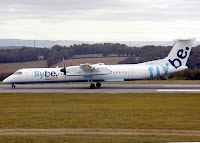 Cabin crew everywhere will be interested to read a report just issued by Britain's Air Accidents Investigation Branch (AAIB) about an in-flight emergency due to smoke inside the aircraft. The cabin crew had to wear smoke hoods during the emergency, but the smoke hoods impaired their ability to communicate with their passengers.
Cabin crew everywhere will be interested to read a report just issued by Britain's Air Accidents Investigation Branch (AAIB) about an in-flight emergency due to smoke inside the aircraft. The cabin crew had to wear smoke hoods during the emergency, but the smoke hoods impaired their ability to communicate with their passengers.According to the AAIB report, on August 4, 2005, a DHC-8-400 aircraft operated by Flybe was en route from Birmingham to Edinburgh with four crew and 56 passengers on board. Smoke developed inside the flight deck and the cabin. The flight diverted to Leeds Bradford International Airport (LBA) where it made a safe emergency landing.
Here is an account of what happened, with excerpts from the AAIB report.
The incident began when the pilots detected an "oily smell" on the flight deck.
They asked the cabin crew, via the interphone, whether the smell was evident in the passenger cabin and, almost immediately, noticed a white/blue haze appearing on the flight deck, accompanied simultaneously by the toilet smoke alarm.The pilots donned their smoke masks and began a smoke checklist.
While the pilots were actioning the checklist the two cabin crew members heard the smoke alarm in the forward toilet sound and then found that the toilet was full of whitish coloured smoke. The senior cabin crew member informed the flight crew using the interphone. The pilots' response was delayed because they were occupied with the checklist actions. The cabin crew then donned smoke hoods.At this point, the captain declared a 'MAYDAY' and descended for an approach to LBA.
...The cabin crew were briefed to prepare the cabin for an emergency landing in 10 minutes and a passenger evacuation on the runway.The report goes on to note that as power was increased during the approach there was a significant increase in the smoke inside the aircraft. Hearing difficulties caused by the smoke hoods prevented the cabin crew from hearing the landing calls from the flight deck.
The cabin crew found the smoke in the cabin getting thicker, until they could no longer see the length of the cabin. The senior cabin crew member played an emergency announcement tape and made a public address to the passengers, briefing them that there would be an emergency landing, for which they should adopt the brace position.
The cabin crew then checked the passengers and secured cabin baggage. Some passengers enquired about breathing protection for themselves, but smoke protection for passengers is not a requirement on public transport aircraft.
The aircraft landed safely at LBA and the passenger evacuation "proceeded in an orderly fashion." There were no injuries.
The AAIB report includes this note about crew communication during the incident:
In their reports on the incident the flight crew noted that, after the emergency had been declared, a high workload had prevented them from communicating with the cabin crew for some time. The cabin crew commented that delays in obtaining a response from the flight deck to cabin emergency calls at times had caused concern as to the state of the flight crew.Regarding the smoke hoods, the report concluded that verbal communication while wearing the hood was difficult for the cabin crew due to "a reduction in speech and hearing volume due to the hood and to interference from relatively loud sounds perceived by the hood wearer, caused by rustling of the hood, the sound of the wearer’s breathing and the sound of the wearer's voice."
It was suggested that consideration should be given to introducing a standard method by which the flight crew could confirm to the cabin crew that they were not incapacitated but were temporarily too busy to reply, such as a triple activation of the seat belt audio alert in the cabin.
The cabin crew also reported that the smoke hoods had severely hindered ommunications with the passengers, impeding both hearing and being heard. Because of this, one of the cabin crew had removed her hood shortly before landing.
The report includes several safety recommendations for improved means of emergency communication between the flight deck and the cabin crew, and for a review of cabin crew training in the use of smoke hoods aimed at the ability to communicate while wearing the hoods.
Click here to view AAIB Bulletin: 4/2007 - Bombardier DHC-8-400, G-JECE (10-page 'pdf' file).
[Photo Source]
